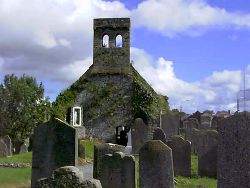
"Old St Mary's"
Français
Italiano
Español

|
"Old St Mary's" |
English
Français Italiano Español |

Old St. Mary's Church, was originally built as one of the satellite churches of the Cahir Abbey during the medieval period, along with others in Killemly, Loughloher, Ballymacadam, Kileenbutler, in response to increased demands on the monastic community.
The parish Church is a multi-period building, constructed largely of local limestone and consisting of a nave and chancel joined by a now partly built-up arch. The walls are three foot thich throughout, except for thr West wall, which is four foot thick, and carries the double bellcote. The present buildings at Cahir Abbey and Cahir Castle belong mainly to the 15th century and certain features of the chancel of the Parish Church would suggest a simular date, although there remains the possibility that it occupies the site of an earlier structure. The features in question are the intricate interlace patterns on the East window, rare examples of the late Celtic medieval revival also found at Cahir Abbey. In Addition there is a corbel on the South wall of the Chancel depicting a carved ecclesiastical head, examples of which are also found on the North-West tower of Cahir Castle and the East window of the Abbey.
After the dissolution of the monasteries by Henry VIII in 1540, the Parish Church would have gradually taken over the monastic duties. Indeed the first recorded Parish Priest of Cahir, Edmond O'Lonergan, was the last prior of the Abbey. By 1596, the parish church was being called St. Mary's, the name which has survived to the present. It has undergone much alteration over the centuries and local tradition claims that for a period after the reformation in 1536, both Catholics and Protestants used the Church simultaneously, the curtain wall between the nave and chancel segretated the two communities. This is probably up to the arrival of Cromwell in 1650, as it was only in the 1600's that the Church of Ireland became territorially organised, with a minister resident in the town. Prior to this (in the 1536-1650 period) several benefices (parish unions) were held together, due to a lack of clergy, parishoners and finance. Cahir remained largely in Roman Catholic and Quaker ownership until the late 18th century, and numbers of Anglicans were very small. Just 63 Protestants (including Quakers) lived in Cahir Parish in 1766.
In the early eighteenth century a thatched Church was built at the entrance to Cahir Park for Roman Catholic Worship, while the old church continued to be used by the Established Church. By 1800 the old Church was Quite dilapidated and there was complaints of over-crowding, so in 1812 Lord Cahir Conveyed a site for the construction of a new church (St. Pauls) which was begun in 1816, finished in 1818 and concecrated in 1820. Old St. Marys was last used for worship in January 1820.
The cemetary surrounding the Old Parish Church was used extensively for both Roman Catholic and Protestant burials during the 18th and 19th centuries. There are quite a few military burials, owing to the proximity of the Cavalry Barracks at Kilcommon. Burials of particlar note include, Richard 1st Earl of Glengall (unmarked); James Butler of Kilcommon, (grandson of the 5th Lord Cahir and the famous Sir Toby Butler); Edmond Purtill, (school master and Gaelic scholar); and Matilda Weller, (the inspiration of the poet James Thomson.